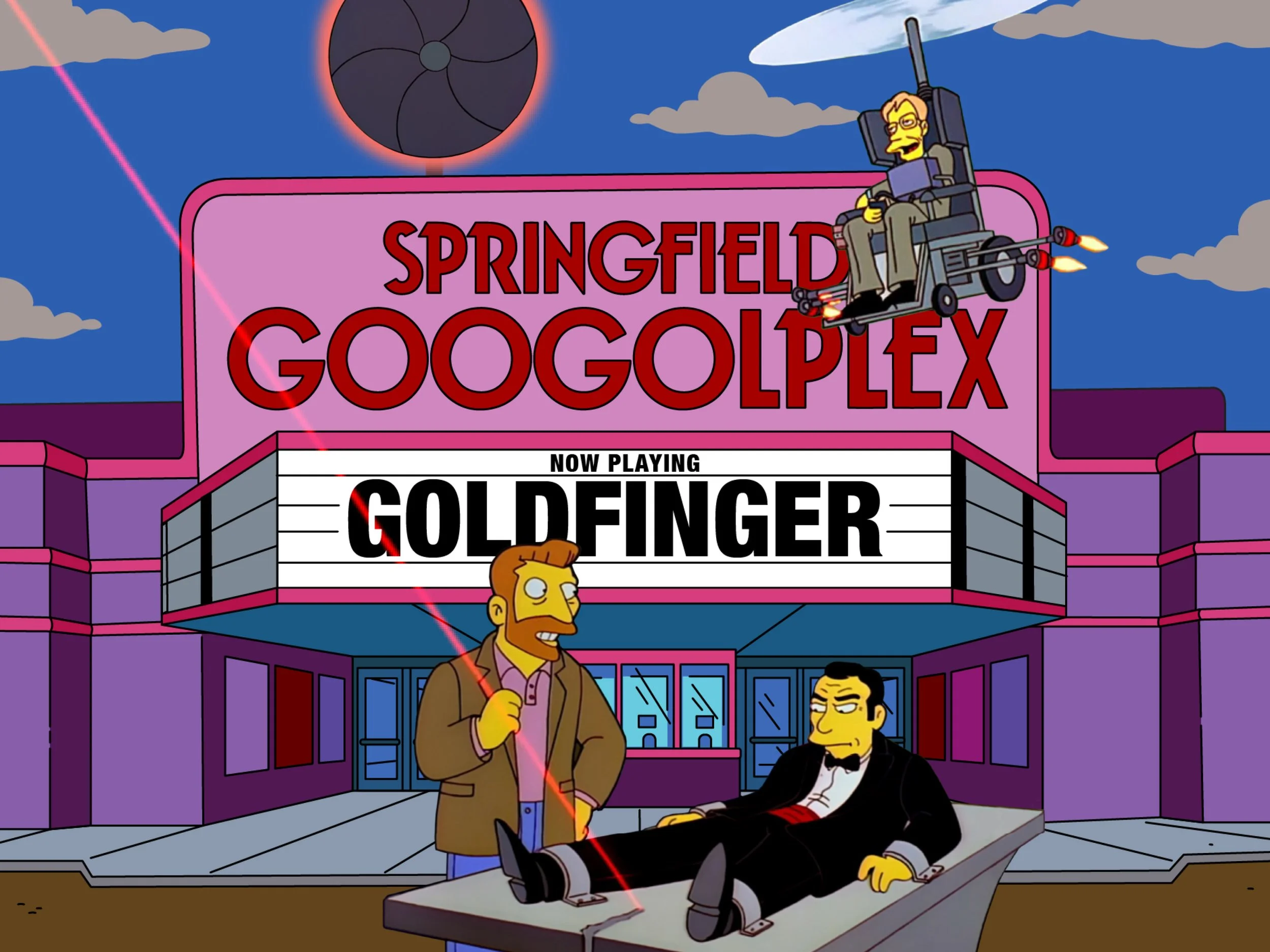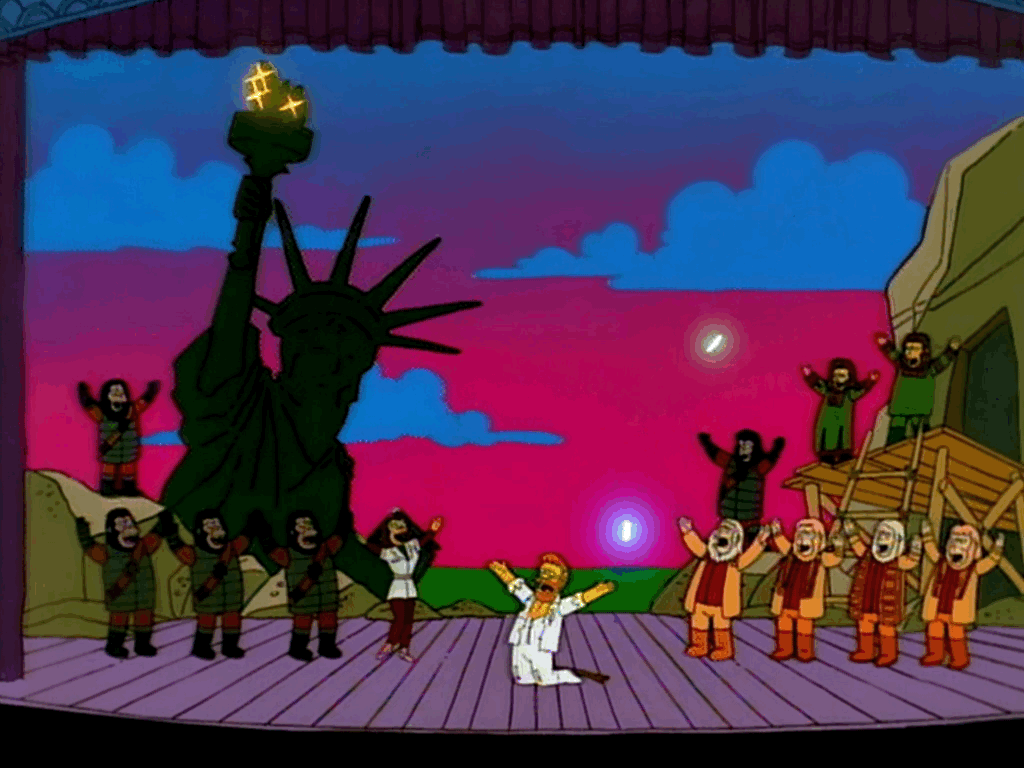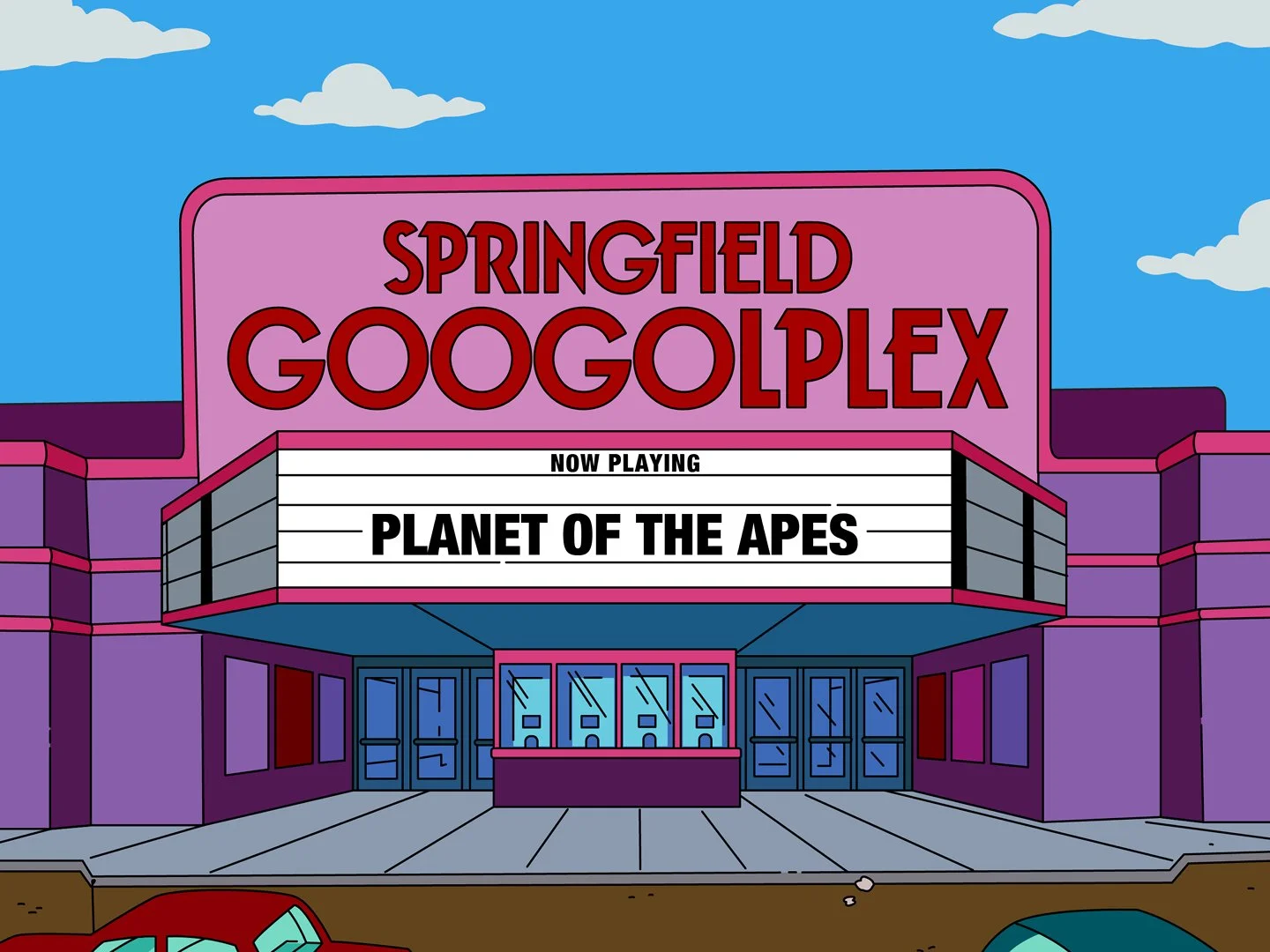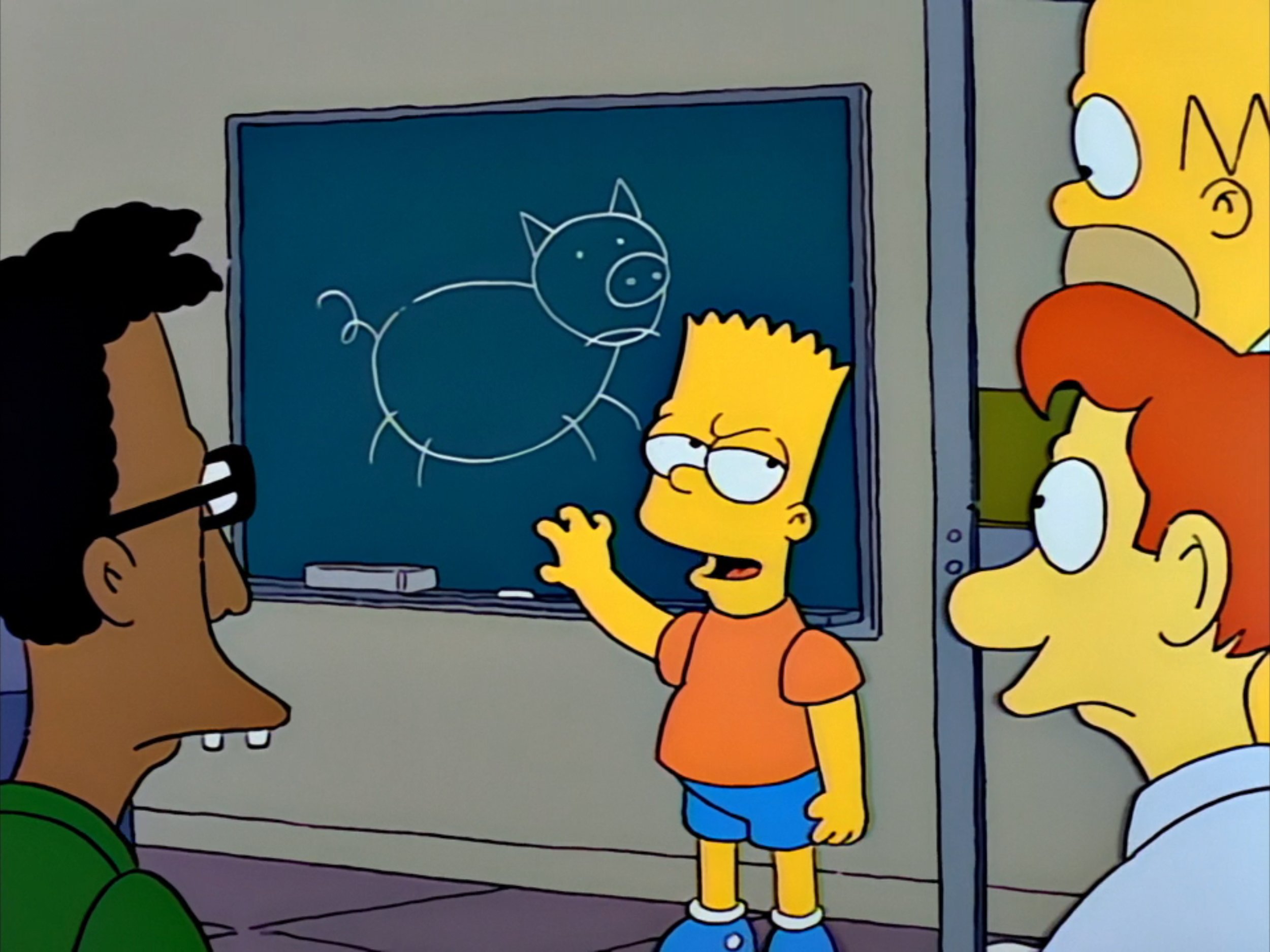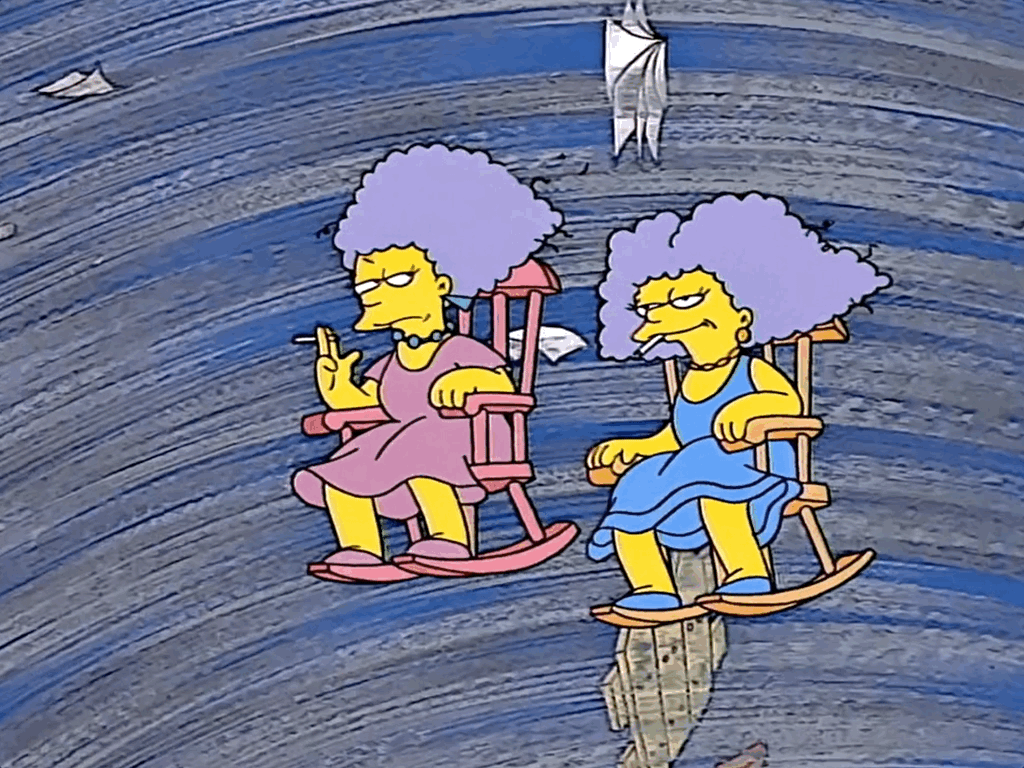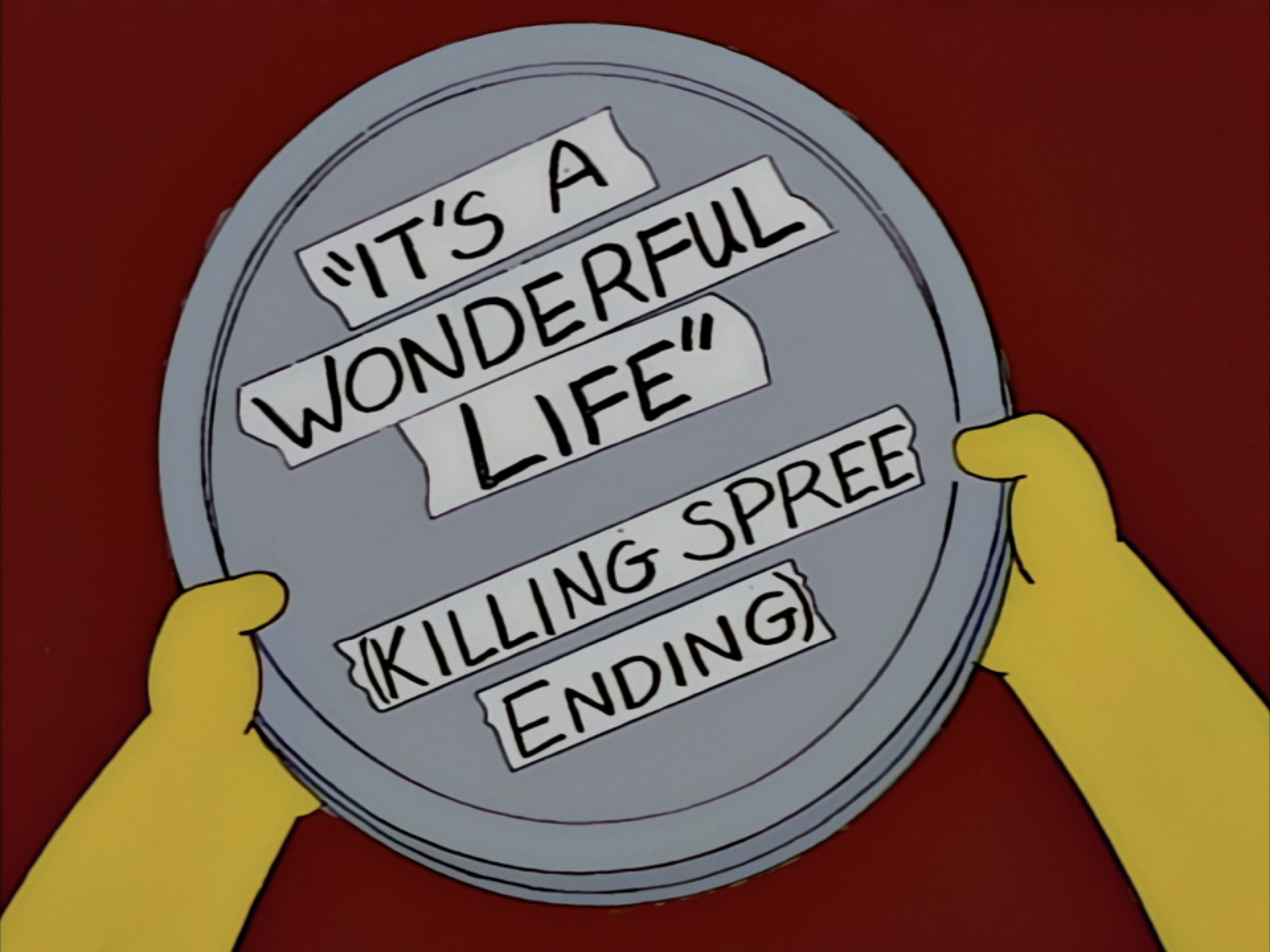The Top 10 Most Referenced Movies on The Simpsons
Many people who grew up with The Simpsons were first introduced to countless classic movies through the show. But what movies were referenced the most in those formative early seasons?
In this article, we rank the movies with the most confirmed references on The Simpsons in the first 13 seasons, based on our Simpsons Movie Reference Database (SMRDb).
10. Goldfinger (1964)
Directed by Guy Hamilton, 1964
Confirmed References: 13
Major References: 6 (46%)
When The Simpsons came on the air, Goldfinger was pretty undeniably the quintessential James Bond movie. And while the show did parody a few scenes directly from the movie, its more baked into the DNA of the show than you might remember.
Soundalikes of John Barry’s brassy score for Goldfinger have become shorthand for cool spy stuff on The Simpsons, y’know, like sucking the center out of a wedding cake using a collapsible straw. The theme song itself, as sung by Shirley Bassey, has been parodied at least three times, including the end credits for the McBain movie, an original theme for Globex’s evil CEO Hank Scorpio, and Homer’s personal jingle when he changes his name to Max Power.
Of course, variations on the movie’s famous laser sequence also make several appearances, from Bart’s tattoo removal in the pilot episode to an episode of Itchy & Scratchy to Scorpio’s trap for James Bondt (yes, “Bondt”). Likewise, Goldfinger himself has been sent up in “Who Shot Mr. Burns,” when Springfield’s own supervillain reveals his plan to block out the sun using a scale model of the city.
More broadly, the Bond aesthetic of big-red-button gadgets and modernist Ken Adam-style buildings seems to have influenced the animators behind The Simpsons far beyond direct Goldfinger parodies.
Listen on the Podcast:
Goldfinger
See every reference to Goldfinger on The Simpsons, and learn more on our full podcast episode.
9. The Godfather (1972)
Directed by Francis Ford Coppola
Total Confirmed References: 15
Major References: 6 (40%)
What can you say about The Godfather? There’s just something about Mario Puzo’s spare and snappy dialogue that seems to stick in the minds of men of a certain age. Whether it’s The Simpsons or The Sopranos, bits of dialogue from the Corleone saga abound in TV shows of the nineties and aughts.
Whenever the Simpson family brushes up against organized crime in Springfield, you can be sure that someone is going to sleep with the fishes or be faced with an offer they can’t refuse (although the writers may also throw in a nod to Goodfellas or The Untouchables for good measure).
But the visual language of the film creeps into civilian life in Springfield too. One scene The Simpsons returns to again and again is the famous horse head sequence. It’s not just that it’s fun to swap out the dead horse with something else, like a living horse or a statue’s head. It seems like the sunrise lighting, the reveal moment, the scream, and the cutting between interior and exterior all offer a satisfying sandbox for animators to play in.
8. Godzilla (1954)
Directed by Ishirô Honda
Total Confirmed References: 16
Major References: 2 (13%)
Before any kaiju visited Springfield, sharp-eyed Simpsons fans may notice a tiny version of Godzilla on Bart’s desk as far back as the first episode of season 2.
Since then, Springfield and other cities around the world have been destroyed by Pierre and Marie Curie, giant corporate mascots come to life, and Rodan—all doing their best Godzilla impression. Well, at least the U.S. Navy is out there every day, protecting us from Godzilla himself. Yvan eht nioj!
Bloodzilla, Zoidzilla, Buttzilla—just like in the real world, there are a lot of spinoffs and knockoffs of Godzilla on The Simpsons. I hope the estate of Ishirō Honda is getting those sweet, sweet royalties. Mmm… royalties.
Listen on the Podcast:
Godzilla (1954)
See every reference to Godzilla on The Simpsons, and learn more on our full podcast episode.
7. Planet of the Apes (1968)
Directed by Franklin J. Schaffner
Total Confirmed References: 16
Major References: 5 (31%)
Perhaps no film has been celebrated on The Simpsons quite like Planet of the Apes. Troy McClure’s musical adaptation in “A Fish Called Selma” (S7E19), Stop the Planet of the Apes, I Want to Get Off!, has been cited as one of the funniest moments ever on the show, and it (more or less) tells the whole story of the movie in two minutes—even if showrunner Josh Weinstein had never seen the original.
But the most referenced aspect of Planet of the Apes is a different kind of musical homage.
For the hilarious flash-forward ending to “Rosebud” (S5E4), Alf Clausen wrote a soundalike of the Planet of the Apes score, which had a long afterlife on the show. It quickly became the go-to music for any kind of mob scene, whether that involves hunting the kids with nets like the apes in this movie, or something totally unrelated like a soccer riot.
Much like Godzilla and some of the movies yet to come on this list, Planet of the Apes also became a sensation through merchandise as much as the film itself. As a result, the iconography of this franchise is dotted throughout the show on T-shirts, radio show sound effects, and pop-culture allusions to animals becoming our masters.
Listen on the Podcast:
Planet of the Apes
See every reference to Planet of the Apes on The Simpsons, and learn more on our full podcast episode. (Warning: This episode is old! We hadn’t quite found our footing yet.)
6. Jaws (1975)
Directed by Steven Spielberg
Total Confirmed References: 17
Major References: 6 (35%)
The Simpsons draws broadly and diversely from Steven Spielberg’s first blockbuster, including the thumping score (duh-dum), multiple shark and dolphin attacks, and the small-town characters and politics of Amity.
Quint the shark hunter’s iconic entrance also gets sent up on more than one occasion. But the most frequently parodied moment is an iconic piece of cinematography: the dolly zoom.
While this technique was invented by Alfred Hitchcock for Vertigo (1958) to replicate the dizzying effects of the hero’s fear of heights, Spielberg created his own version by adding a face in the middle of the warping background. Ever since Lisa first saw Kang and Kodos in the very first “Treehouse of Horror” (S2E3), this version of the dolly zoom has become part of the Simpsons visual vocabulary, from courtroom twists to grizzly discoveries.
Listen on the Podcast:
Jaws with Devan Scott
See every reference to Jaws on The Simpsons, and learn more on our full podcast episode.
5. Citizen Kane (1941)
Directed by Orson Welles
Total Confirmed References: 18
Major References: 11 (61%)
With a gun to our heads, we would have guessed Citizen Kane was the most referenced film on The Simpsons. At various points in the DVD commentary, the writers observe that you could probably recreate the entire movie by cutting together the many lengthy parodies on the show.
But as it turns out, while Orson Welles’ masterpiece may be The Simpsons’ most thoroughly referenced film, it’s not necessarily its most frequently referenced.
Mr. Burns often provides the alibi to recreate an entire scene from the movie. In particular, “Rosebud” (S5E4) Simpsonizes the film’s core plot: a heartless miser’s attempt to reunite with his prized childhood possession.
But Burns’ run for governor, his Xanadu-like mansion, and Smithers’ musical tribute to him are all more subtle references to the life and times of Charles Foster Kane.
4. Frankenstein (1931)
Directed by James Whale
Total Confirmed References: 20
Major References: 5 (25%)
What movie screams horror more than Frankenstein?
While “Treehouse of Horror II” (S3E7) includes a segment-long parody of the famous monster movie, the brunt of the references are much smaller, like Halloween costumes and multiple creepy credits, sometimes even within one episode—I’m looking at you, Fran-Ken Tsumara-Stein.
However, Frankenstein’s greatest contribution to The Simpsons has to be Marge’s classic opening to the first “Treehouse of Horror” (S2E3), which became a key part of the annual tradition. Worried that their fiendish experiment would raise the ire of protective parents, the makers of The Simpsons added this introductory parody to soften the blow.
3. Psycho (1960)
Directed by Alfred Hitchcock
Total Confirmed References: 26
Major References: 5 (19%)
There is no shortage of iconic moments to parody in Alfred Hitchcock’s most iconic thriller. The most obvious is the famous shower murder scene, which Maggie once recreated in detail (and tried to recreate twice more), inspired by the violence on The Itchy & Scratchy Show.
More subtle are the many nods to cinematography, production design, and score. In particular, the violin stings from the famous shower scene have become a shorthand on the show for murderousness. Likewise, by our count, the Bates family home (or a lookalike) makes at least five appearances on the show as one cursed-ass house or another.
But the relationship between Principal Skinner and his mother Agnes provides some of the funniest references to Psycho in the series. While there are only a few of these direct parodies—like a one-sided conversation between Skinner and mother in “Brother from the Same Planet” (S4E14)—the regular creepy interactions between Seymour and Agnes keep the Psycho vibes going long after any official reference.
2. Star Wars (1977)
Directed by George Lucas
Total Confirmed References: 31
Major References: 3 (10%)
Considering how many references there are to Star Wars on The Simpsons, it’s surprising how few of them are full-on scene or plot parodies. More than half of them are just mentions, allusions, and background text or visuals. More than anything, the writers use Star Wars to poke fun at what we would now call “fandom,” and particularly how obsessive and critical fans of The Simpsons could be. (“Worst episode ever.”)
However, versions of a few classic lines of dialogue have occasionally found their way into the show. Consider, for example, the multiple references to Obi Wan’s ghostly advice to “use the force.” Or when Patty says of Lisa, "The bitterness is strong in this one." Or when Ralph Wiggum observes, “I bent my wookiee.”
Of course, a guest appearance by Mark Hamill in “Mayored to the Mob” (S10E9) opened up an episode-long opportunity to poke fun at Star Wars, but the writers seem more interested in destroying C-3P0 and inventing musical mashups (“Luke be a jedi tonight…”) than recreating entire scenes in great detail.
1. The Wizard of Oz (1939)
Directed by Victor Fleming
Total Confirmed References: 32
Major References: 8 (6%)
On a list of Matt Groening’s 100 favorite things, Victor Fleming’s The Wizard of Oz comes in at #7. It’s the highest movie on the list, though it can’t compete with “Vietnamese spring rolls or sex.”
So maybe it’s no surprise that The Wizard of Oz is woven into the very fabric of The Simpsons from the beginning. Citizen Kane may be able to claim the title of most thoroughly recreated, but Oz finds its way into over 30 blink-and-you-miss-it moments.
Part Darth Vader, part Charles Foster Kane, and part Wicked Witch of the West, Mr. Burns has stocked his mansion with guards that sing “March of the Winkies” and a cage of “flying” monkeys, ready to be tossed out the window.
Many of the movie’s musical numbers make a brief appearance, too. Ned and Rod Flanders sing their own version of “We Welcome You to the Munchkin Land” when the Simpsons first move in, while John Waters’ car horn plays “Somewhere Over the Rainbow.”
In terms of bigger parodies, Unky Herb says his goodbye to the family by giving each one of them a gift like the titular Wizard, and of course, the ending of the movie when Dorothy wakes up back in Kansas gets The Simpsons treatment at least twice.
But why The Wizard of Oz?
Well, Oz is colorful and surreal. It’s full of boisterous music, wacky characters, and clever dialogue. It has a dark, satirical edge just below the surface. Sound familiar? When you think about it, The Wizard of Oz is so at home in The Simpsons that we barely even noticed it.
Honorable Glavins
A few honorable mentions go to three movies that could have cracked the top 10 but don’t because of technicalities.
The first movie was in our top 10 the first time we compiled it, but got booted out when we decided to only count confirmed references, rather than all references.
The second and third movies, have many references to them on The Simpsons, but most of them should probably be attributed to the popular TV series that predate the movies—even if they technically apply to the movies, too.
It’s a Wonderful Life (1946)
Directed by Frank Capra
Total Confirmed References: 11
Major References: 5 (45%)
Total Unconfirmed References: 6
Teacher says every time a bell rings, The Simpsons references It’s a Wonderful Life. Much like Citizen Kane, a good chunk of this film could be recreated through Simpsons parodies, from the most memorable moments to the tiniest details.
More than any other movie on this list, however, It’s a Wonderful Life also speaks to the heart that always made The Simpsons more than just a bundle of gags. Much like Frank Capra’s most beloved film, many a memorable Simpsons episode is 99% devastating, with a 1% slice of uplift at the end.
On the commentary, the writers often credit those touching moments to producer and one-time showrunner James L. Brooks (to whom Frank Capra coincidentally gave his first academy award for Terms of Endearment in 1984). But other times, the juice comes from outside the writers room. As Mike Reiss writes in Springfield Confidential, “If you want to make a touching TV show, rip off a touching movie.”
It’s a Wonderful Life definitely fits the bill.
Listen on the Podcast:
It's a Wonderful Life with Daniel Baptista
See every reference to It’s a Wonderful Life on The Simpsons, and learn more on our full podcast episode.
Star Trek: The Motion Picture (1979)
Directed by Robert Wise
Total Confirmed References: 1
Major References: 1 (100%)
Total Indirect References: 39
It seems like every geek in Springfield owns a pair of Vulcan ears. Much like Star Wars, the Simpsons writers regularly use Star Trek and its film adaptations to joke about their love-hate relationship with geekdom.
This became particularly prominent as the internet grew up alongside the series. As Homer once put it, "The information superhighway showed the average person what some nerd thinks about Star Trek."
Batman: The Movie (1966)
Directed by Leslie H. Martinson
Total Confirmed References: 0
Major References: 0 (0%)
Indirect References: 37
References to the sixties incarnation of Batman helped give the show a taste of the surreal even early on.
Back in season 1, Homer whimsically calls Mr. Burns’ home “stately Burns Manor,” and by seasons 3 and 4, we are treated to spinning interstitials, several Batmobile montages, and multiple matching fire poles. And, since Fox owns the rights, we even hear the actual Batman TV theme song on the show a couple of times, rather than an Alf Clausen soundalike.
Listen on the Podcast:
Batman: The Movie (1966) with Daniel Grant
See every reference to Batman: The Movie on The Simpsons, and learn more on our full podcast episode.
But wait, there’s more!
Those are the most referenced movies in the first 13 seasons of The Simpsons, but we’ve found confirmed references to 880+ movies so far in our search.
That’s what the Springfield Googolplex podcast is all about. Every episode, hosts Adam and Nate pick one of these movies they haven’t seen before (or haven’t seen in a while) to watch, dissect them, and relate them back to our favorite Simpsons parodies.
So as you plan your next movie night, why not join us and let a classic episode of The Simpsons inspire your choice? Eat my shorts, streaming algorithms!
Explore the Data
Best viewed on desktop.
This spreadsheet sorts every movie referenced on The Simpsons by the number of total confirmed references (with ties broken by major references, claimed references, and indirect references).
Try searching for your favorite movie or filtering by your favorite director or decade!
Want more sweet, sweet numbers? Check out the full Simpsons Movie Reference Database.
This list is a work in progress.
Last updated: October 4, 2025.







